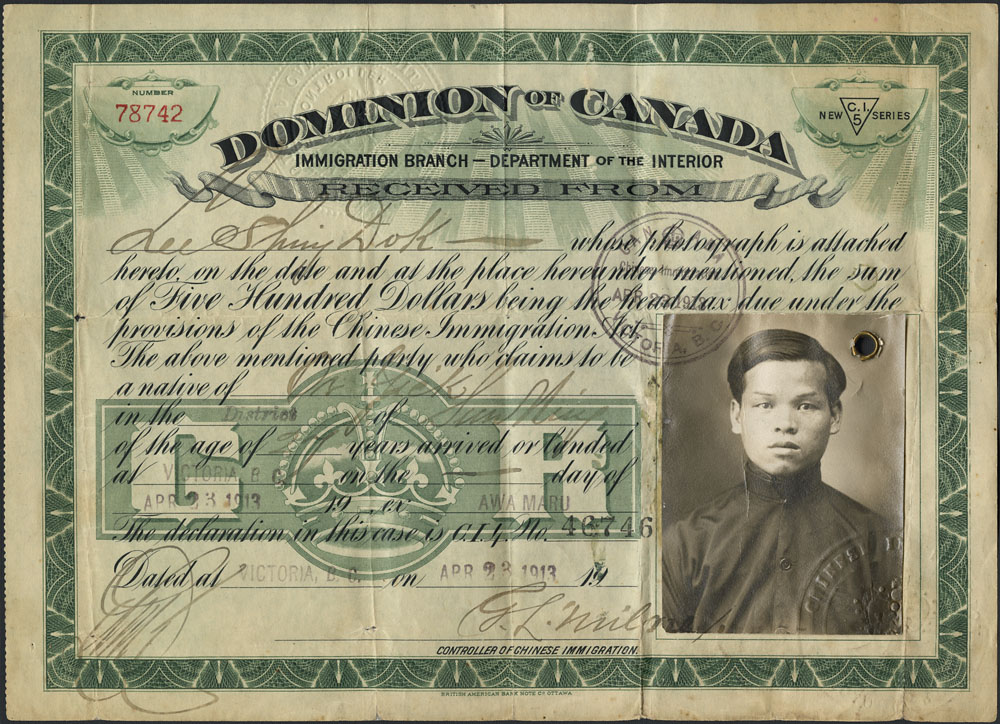
Between 1885 and 1923, Chinese immigrants needed to pay the head tax. They needed to pay if they wanted to immigrate to Canada. The Canadian government wanted to discourage Chinese immigration. The head tax made it difficult for many Chinese people. Many could not bring their family with them to Canada. In 1923, Chinese immigration became illegal until 1947. The federal government apologized for the head tax in 2006.
(This article is a plain-language summary of the Chinese Head Tax. If you are interested in reading about this topic in more depth, please see our full-length entry, Chinese Head Tax in Canada.)

Chinese immigration to Canada began in the late 1850s. Most went to British Columbia. They came because of the Fraser River gold rush. In the early 1880s, about 15,000 Chinese workers went to British Columbia. They helped construct the Canadian Pacific Railway. In 1882, the government in BC tried to ban Chinese immigration. They did not want any non-European immigrants in BC. Prime Minister John A. Macdonald did not support the ban. He knew that the CPR needed Chinese workers. After the CPR was completed though he too wanted to stop Chinese immigration. Many other politicians felt the same. (See Immigration Policy in Canada.)
In 1884, Macdonald created a Royal Commission. The Commission talked about how to slow down Chinese immigration. It did not want to exclude all Chinese immigrants. BC needed these immigrants to fill jobs. To slow down immigration it suggested that all Chinese immigrants should pay a head tax. This would make it hard for many people to immigrate. Many did not have the money needed. Starting in 1885, Chinese immigrants had to pay a $50 head tax. This was the first head tax in Canadian history. In 1901, the head tax became more expensive. It rose to $100. In 1903, it rose to $500. In 1923, the head tax ended. That year, Ottawa passed the Chinese Immigration Act. This stopped all Chinese immigration. Only diplomats and small numbers of merchants and students were allowed in Canada.
The Chinese were the only immigrants who paid a head tax. In addition to paying the head tax, they faced much other discrimination too. They could not vote. They could not practice law or medicine. They could not become politicians. And, they were discriminated against by members of the public in their daily lives. They were considered to be lesser than by a large percentage of members of mainstream Canadian society. (See Anti-Asian Racism in Canada.)
The discriminatory immigration policies had a deep effect on Chinese families. Most immigrants were men. Many of these men had wives and children in China. They could not afford to bring them to Canada because of the head tax. By 1911, the number of Chinese men far outnumbered the number of Chinese women in Canada. The ratio was 28 to 1. The men stayed single. Many of the wives and children in China suffered a lot. The men in Canada sent back money, but it was never enough. Many of the wives and children left in China were poor.
In 1947, the Chinese Immigration Act was cancelled. Since then, Chinese Canadians have sought redress. Redress means to right the wrongs of the past. Two important organizations which sought redress were the Chinese Canadian National Council (CCNC) and the National Congress of Chinese Canadians (NCCC). In 2006, Prime Minister Stephen Harper apologized to the Chinese who paid the head tax and their families. In 2009, Canada compensated $20,000 to around 800 head tax payers or family members. In 2008, the government created Canada’s Community Historical Recognition Program. These are just the first steps toward trying to heal the wounds of the past.